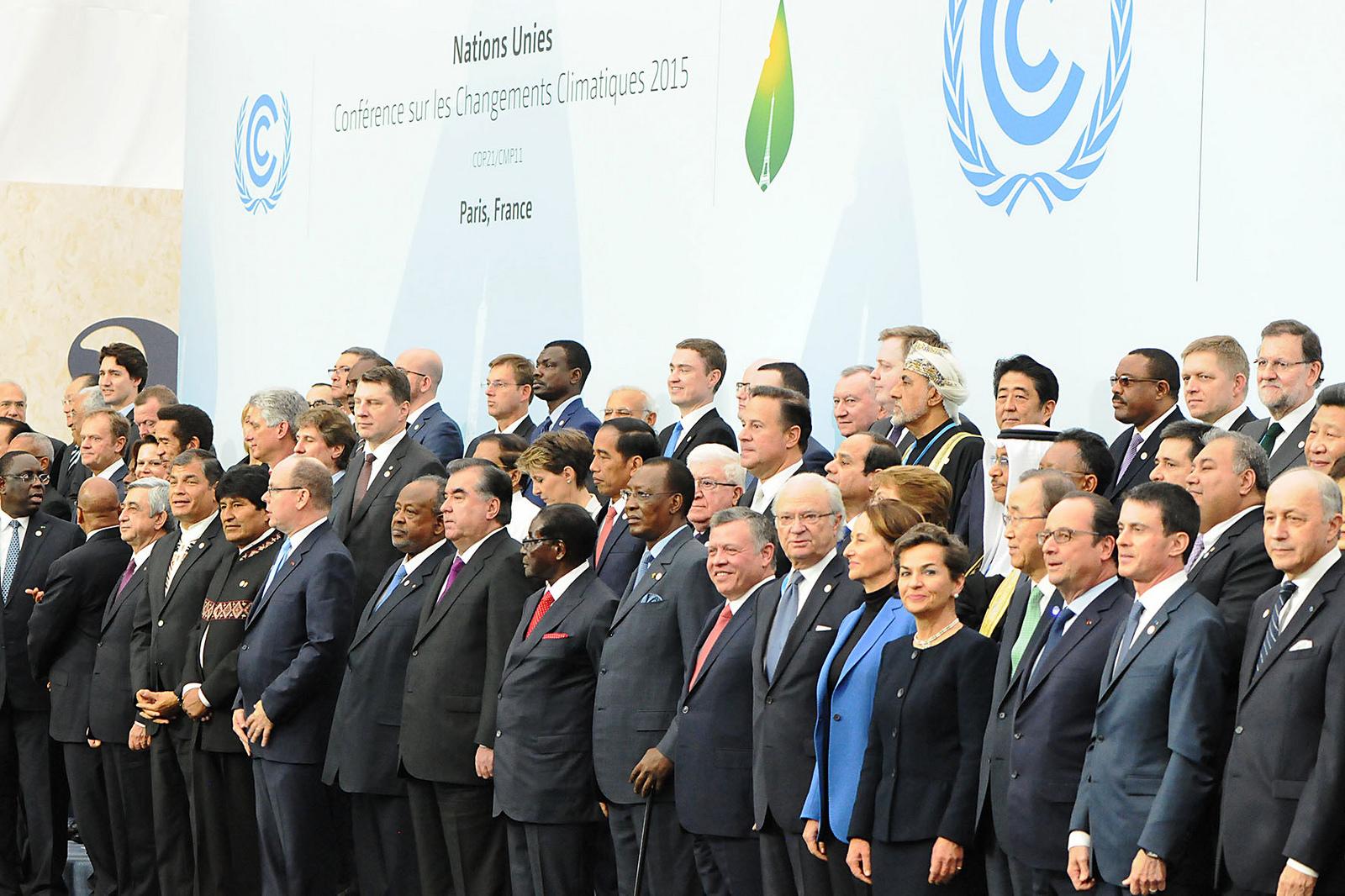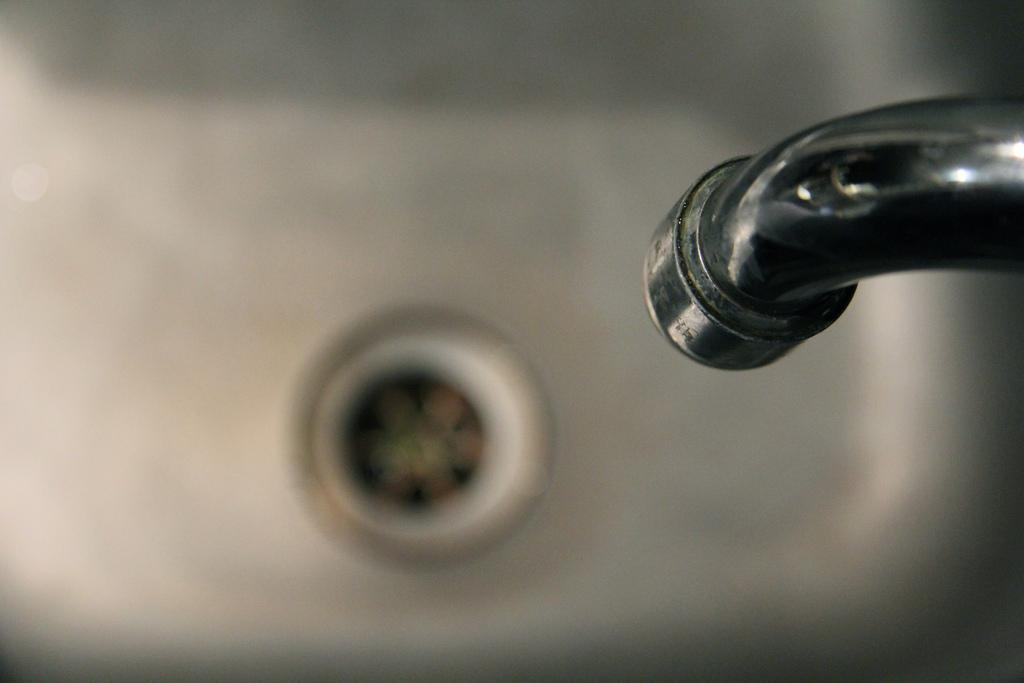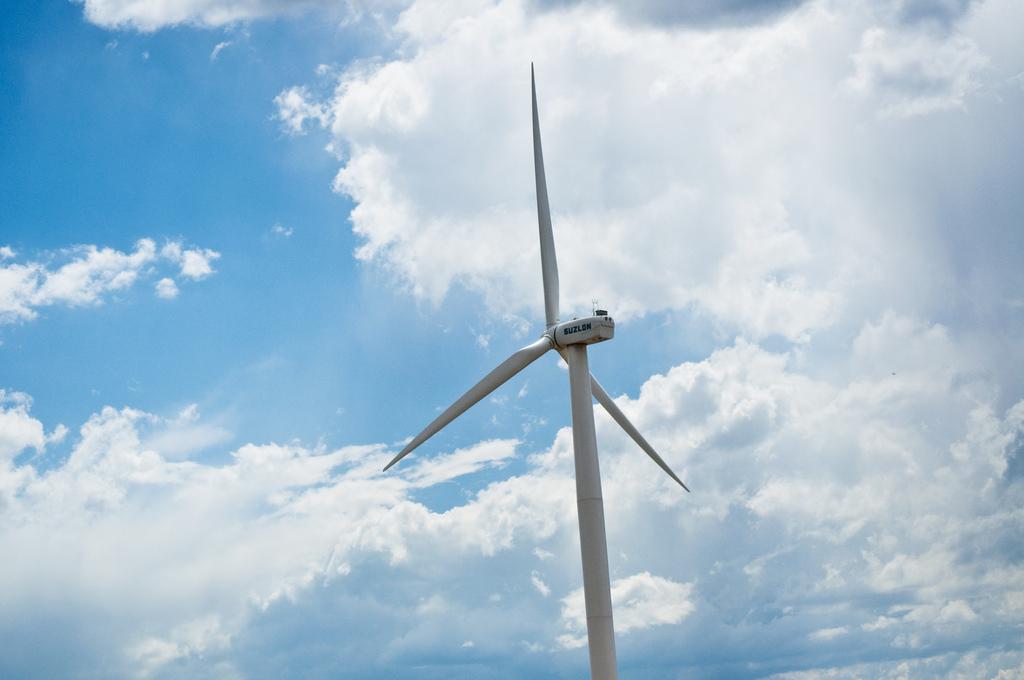-
Posts
209 -
Joined
-
Last visited
-
Days Won
9
Green Blog last won the day on November 30 2023
Green Blog had the most liked content!
Profile Information
-
Gender
Not Telling
Recent Profile Visitors
28,916 profile views
Green Blog's Achievements
-
Md. Awal Ali started following Green Blog
-
 Simon reacted to a article:
COP21: World leaders begin push for a new climate deal at critical Paris summit
Simon reacted to a article:
COP21: World leaders begin push for a new climate deal at critical Paris summit
-
 ahmehedi reacted to a article:
COP21: World leaders begin push for a new climate deal at critical Paris summit
ahmehedi reacted to a article:
COP21: World leaders begin push for a new climate deal at critical Paris summit
-
 haglund1978 reacted to a article:
COP21: World leaders begin push for a new climate deal at critical Paris summit
haglund1978 reacted to a article:
COP21: World leaders begin push for a new climate deal at critical Paris summit
-
 Mas Ery reacted to a article:
COP21: World leaders begin push for a new climate deal at critical Paris summit
Mas Ery reacted to a article:
COP21: World leaders begin push for a new climate deal at critical Paris summit
-
World leaders gathered today in Paris for COP21, a UN summit aimed at reaching a new international climate deal that can avert the worst effects of global warming. French President François Hollande opened the 21st annual Conference of Parties (COP21) summit by stating that the “future of the planet, the future of life” was at stake. “The challenge of an international meeting has never been so great,” Hollande said. Delegates and leaders from 195 countries – along with members from scientific groups, the private sector, indigenous leaders, environmental activists and labour groups – will attend the important UN climate change conference that will take place between November 30 and December 11. Although, the heads of state will only be present during the beginning of the summit. During these crucial days the delegates will work towards a new international climate change agreement that can replace the Kyoto protocol, which is the world’s only legally binding climate change agreement. The Kyoto protocol initially only covered rich and developed countries who are required to cut emissions by 2020 when the treaty expires. The protocol now covers only a handful of countries, including Australia and the member states of the European Union. The United States signed but never ratified the Kyoto protocol. It’s therefore crucial that a new global climate treaty, and one which includes all nations such as China which is currently the world’s biggest polluter, is reached and agreed on in Paris. The delegates will try to reach a deal that will limit global warming to safe levels, i.e. the 2-degrees Celsius target that world leaders have endorsed. In order to keep global temperatures below 2-degrees Celsius, substantial cuts in greenhouse gas emissions are needed. If no action is taken and no agreement is reached at the Paris summit, the UN has said that the world will be on track for a +3 degrees increase in global temperatures. Scientists are warning that we are already halfway to that critical point as the world has already warmed 1 degree Celsius compared to pre–Industrial Revolution temperatures. But the truth is that the 2-degrees target is not really a safe level and scientists and environmental groups – as well as several heads of state – are calling for emission reductions that will stop global temperatures to increase beyond 1.5 degrees Celsius. Countries most at risk from climate change, such as several island states and poorer developing countries, want to see a more ambitious climate agreement. But the likelihood that the rich and developed nations will agree to such reductions are highly unlikely. This question, about developed nations obligations and their historic responsibility, along with the question of economic assistance to developing nations will surely – and yet again – cause a rift between the delegates at the climate summit. Speaking at the opening ceremony today in Paris, President Barack Obama said that the US recognised its responsibility to help limit global warming. “As the leader of the world's largest economy and the second largest emitter […] the United States of America not only recognizes our role in creating this problem, we embrace our responsibility to do something about it,” Obama said. Similar speeches from world leaders could be heard during the 2009 climate change conference in Copenhagen – and that summit ended in a failure. But things are different this time around. More nations are now feeling the effects of global warming, the science on climate is clear and on point, and renewable energy technologies are improving while their costs are drastically decreasing. And this time around, the world’s two biggest greenhouse gas emitters, China and the US, are both supportive of a new climate deal. But there are still several worrying obstacles ahead. While China may be more positive of a climate change agreement this time around, the commitment from India, the world’s third biggest emitter, remains uncertain. The US and EU also has different stances on how much of the new climate agreement should be legally binding – Obama and the US government are pushing for less as a legally binding treaty would be difficult to pass in the US Senate. So far, more than 170 nations – representing 97 percent of the world’s total emissions – have submitted climate pledges to the UN ahead of the climate summit in Paris. But those pledges are currently too weak and will, according to analyses, result in a 2.7 to 3.3-degrees Celsius increase in global temperatures. Despite all of this the hopes and expectations are high on the Paris climate summit to make substantial progress in the fight against climate change. And hopefully it won’t end in a whimper this time, as it did in Copenhagen back in 2009.
-
- global warming
- unfccc
- (and 8 more)
-
 Pamela Harris reacted to a article:
UN warns the world could face a catastrophic global water crisis by 2030
Pamela Harris reacted to a article:
UN warns the world could face a catastrophic global water crisis by 2030
-
 Ann Hunt reacted to a article:
Bill McKibben: The IPCC still underestimates the situation
Ann Hunt reacted to a article:
Bill McKibben: The IPCC still underestimates the situation
-
California Governor Jerry Brown has declared a state of emergency following a devastating oil pipeline spill along the unique Santa Barbara coast. The move will help free up resources which will help in the clean-up process – but experts say the local environment might never recover from this ecological disaster. It’s estimated that more than 400,000 litres of crude oil was spilled before the ruptured pipeline was discovered. Officials have estimated that around 80,000 litres of oil has reached the sea. “This emergency proclamation cuts red tape and helps the state quickly mobilize all available resources,” said Governor Brown. “We will do everything necessary to protect California's coastline.” Workers outfitted in protective suits and helmets are on the beach, shoveling up contaminated mud and rocks into plastic bags. Photo credit: Greenpeace USA. The ruptured pipeline, which is owned and operated by the Plains All-American pipeline company (PAAP), was built in the late 1980’s and the company claims it was thoroughly inspected in 2012 and that it underwent similar test about two weeks ago – although those test results had not yet been analysed, Al Jazeera reports. Environmentalists are saying that this accident shows, yet again, that oil companies are incapable of regulating themselves. “Oil spills are never accidents,” said Annie Leonard, Executive Director of Greenpeace USA, in a statement. “They are the direct result of substandard oversight of fossil fuel companies who put their profits above human and environmental impacts.” Kathryn Phillips, California director of environmental group Sierra Club, asked: “How many more signals do we need from the oil industry that public health and the environment aren't at the top of its list when it decides how much to invest in creating its products?” “It's time we all demand better from this incredibly wealthy industry,” Phillips said. The pipeline company has said that they take full responsibility for the accident and that they will pay for all costs associated with this devastating oil spill. “We apologise for the damage that has been done to the wildlife and to the environment and we’re very sorry for the disruption and inconvenience it has caused on the citizens and visitors to this area,” said PAAP’s boss Greg Armstrong. Santa Barbara was the scene of a much bigger oil spill in 1969 which is said to have been responsible for launching the environmental movement in the US. The question is, will this oil spill change anything?
-
Simon started following Green Blog
-

Costa Rica is now running on 100 percent renewable energy
Green Blog posted a article in Renewable Energy
Costa Rica has been getting all of its electricity from renewable energy sources since the beginning of the year. “The year 2015 has been one of electricity totally friendly to the environment for Costa Rica,” the state-owned power supplier Costa Rican Electricity Institute (ICE) announced in a press release. The country hasn’t had to use any fossil fuels so far in 2015, much thanks to heavy rain that has kept the country’s hydroelectric power plants working at full capacity without any interruptions. This accomplishment is no random luck, it’s the result of hard work to reach the country’s goal to become carbon-neutral by 2021, as Costa Rico announced back in 2009. “We are declaring peace with nature,” Costa Rican ambassador Mario Fernández Silva said in 2010 when his country won the Future Policy award. “We feel a strong sense of responsibility about looking after our wealth of biodiversity. Our attitude is not progressive, it is conservative. Our view is that until we know what we have, it is our duty to protect it.” Costa Rica has also generated additional electricity from various other renewable energy sources – such as wind, biomass, geothermal and solar energy. Last year, hydropower accounted for 80 percent of the total electricity used while geothermal reached upwards of 10 percent. Approximately 94 percent of Costa Rica’s energy comes from renewable energy sources. But their energy system is sensitive to climate and weather disruptions due to their hydro power plants being based on so called run-of-the-river systems. They can therefore be hindered because of seasonal changes in water flow or drought – something which is becoming far too common due to climate change. CleanTechnica reports that Costa Rica are planning to build three new geothermal projects, capable of generating 50-55 MW each, to help diversify their energy portfolio. These new geothermal plants will help Costa Rica to continue to produce clean, renewable energy when the country’s hydropower plants are unable to produce electricity. It’s worth pointing out that Costa Rica is a small nation with a population of only around 4.8 million people. The country also does not have much heavy and energy-intensive industries, and mainly relies on tourism and agriculture. Despite this, Costa Rica’s accomplishment gives us hope and it should inspire other nations to increase their renewable energy efforts.- 2 comments
-
- energy
- costa rica
-
(and 4 more)
Tagged with:
-
In just 15 years the world could suffer a catastrophic global water crisis, the United Nations (UN) warn in its annual World Water Development Report. The UN report forecasts that global water demand will increase by 55 percent by 2050. If current trends of water usage continues the world could suffer a 40 percent shortfall in water supply as early as by 2030 – which could potentially have catastrophic consequences. Groundwater supplies are quickly diminishing and the report estimates that 20 percent of the world’s aquifers are currently over-exploited. There is an urgent need to manage water more sustainably, the UN report concludes. If we fail to do this, the competition for water will increase and lead to “significant impacts” on both the economy and human well-being. It will also increase the risk of conflicts, the UN report warns. Safe drinking water supplies will continue to dwindle as long as water pollution continues to be ignored and go unpunished by local authorities, and water use remains wasteful and unregulated, as it unfortunately does in many nations, the UN says in its report. In order to mitigate this water crisis, the UN is urging politicians, communities and industries to rethink its water policies and to make a greater effort to conserve water. The 55 percent increase in water demand is mainly due to growing demands from manufacturing, thermal electricity generation and domestic use. But due to increasing population numbers and consumption levels, agriculture will also need to substantially increase its food productions to keep up with demand – and this will in turn increase water usage. “By 2050, agriculture will need to produce 60 percent more food globally, and 100 percent more in developing countries […] global water demand for the manufacturing industry is expected to increase by 400 percent from 2000 to 2050, leading all other sectors, with the bulk of this increase occurring in emerging economies and developing countries,” the UN report said. “Unless the balance between demand and finite supplies is restored, the world will face an increasingly severe global water deficit.” Considering that current demands for water in the agriculture sector is already unsustainable, this will be a difficult task. The agriculture sector must increase its water use efficiency by reducing water losses in the production process, and to “increase crop productivity with respect to water” availability and demand, the report says. The UN report also points to two worrying global trends that are converging: climate change and growing economic development in poor developing countries. This convergence will especially “intensify the water insecurity of poor and marginalized people in low income countries.” “Water resources are a key element in policies to combat poverty, but are sometimes themselves threatened by development,” said UNESCO Director-General, Irina Bokova. “Water directly influences our future, so we need to change the way we assess, manage and use this resource in the face of ever-rising demand and the over exploitation of our groundwater reserves.”
-
- un
- united nations
- (and 7 more)
-
US President Barack Obama has signed an executive order to cut the federal government’s carbon pollution emissions by 40 percent by 2025. The new plan is expected to result in a reduction of 21 million metric tons of greenhouse gas emissions – which is equal to taking 4.2 million cars of the road for a year. Alongside of this, the share of renewable energy used by the federal government will increase to 25 percent. The plan is also expected to save taxpayers up to $18 billion in reduced energy costs. “Today’s action builds off of the strong progress the federal government has made over the past six years,” the White House writes in a statement. “Already, federal agencies have reduced greenhouse gas emissions by 17 percent since the President took office, and increased the share of electricity consumed from renewable sources from 3 percent to 9 percent in 2013.” Other measures included in the plan consist of a reduction in energy use in federal buildings by 2.5 percent a year, a reduction in water intensity by 2 percent over the next decade, and a 30 percent reduction of per-mil greenhouse gas emissions from the federal vehicle fleet by 2015 – while at the same time increasing the use of zero-emission and plug-in hybrid vehicles. The reduction plan will be based on emission levels from 2008 and will only involve the US federal government. Although the federal government only contribute modestly to the US’s total greenhouse gas emissions, many see this as a move that’ll hopefully spur other sectors of the country into action, and especially the federal government’s supply chain. The Department of Defense currently has the largest carbon emissions of the US federal government. So far the department has reduced its emissions by 10 percent and is now aiming to install another 3 gigawatts of renewable energy on military buildings by 2025 — enough to power 750,000 homes. “Earthjustice applauds President Obama for issuing an Executive Order today that aims to make a significant cut in carbon pollution—the pollution responsible for climate change—from the government sector,” said Abigail Dillen, Earthjustice’s vice president of litigation for Climate & Energy. “The President recognizes that the federal government can lead the way in expanding our use of clean, renewable energy, a key step on the path to end our nation’s unnecessary dependence on fossil fuels that harm our health and the environment.” The US government hopes that this new sustainability plan will strengthen the country’s “leadership on the international stage”, while “ensuring that we can tackle the global threat of climate change and leave behind a safer, more prosperous world.” But for that, we’ll need to see much tougher climate ambitions from the US – something which today unfortunately seems highly unlikely.
-
- climate change
- federal government
- (and 6 more)
-

New rooftops in France must be covered in plants or solar panels
Green Blog posted a article in Politics
France has issued a new eco-friendly law which requires rooftops on all new buildings in commercial zones to be partially covered by plants or solar panels. The new law, which was approved at the end of last week by the French parliament, was much more limited in its scope than what French environmental activists had campaigned for. They had called for a law which required all new rooftops in France to be fitted with green roofs. But the socialist government managed to convince the activists to accept this limited law which only requires new roofs in commercial zones to be partially covered in plants. The law also gives house owners the choice of either installing a green roof or solar panels for electricity generation instead. But even if this is a trimmed-down version, the law will have positive effects for the French urban landscape. Green roofs are living roofs which are covered with grass, shrubs, flowers or other plants that gives birds a place to nest in the urban environment. These green roofs will also retain rainwater, helping reduce problems with stormwater runoff. Another benefit is that much less energy is required to heat or cool buildings which has a green roof installed. The law might also help France catch up to other major European countries – such as Germany, Spain and Italy – which has a much larger share of solar energy. Photovoltaic capacity just amount to over five gigawatts, or about one percent of the total energy consumption, in France. And this while Germany has nearly 40 gigawatts installed.-
- renewables
- solar power
- (and 6 more)
-
It’s been revealed that the Gates Foundation, run by Bill and Melinda Gates, has held at least $1.4 billion of investments in some of the world’s biggest fossil fuel companies – while at the same time calling for immediate action against climate change. “The companies include BP, responsible for the Deepwater Horizon disaster in the Gulf of Mexico, Anadarko Petroleum, which was recently forced to pay a $5bn environmental clean-up charge and Brazilian mining company Vale, voted the corporation with most “contempt for the environment and human rights” in the world clocking over 25,000 votes in the Public Eye annual awards,” the Guardian writes. The Bill and Melinda Gates Foundation is one of the world’s largest charities with an endowment of $42.3 billion. Its primary aims are to enhance healthcare and reduce extreme poverty. The foundation has been giving billions in grants to various health programmes around the world since its launch back in 2011. Last year, it was involved in a health programme that helped rid India of polio. In its annual letter, titled Our Big Bet for the Future, Bill and Melinda Gates called on aggressive action against climate change: “The long-term threat [of climate change] is so serious that the world needs to move much more aggressively – right now – to develop energy sources that are cheaper, can deliver on demand, and emit zero carbon dioxide.” But apparently, both Bill and Melinda have missed that their investments in oil, gas and coal helps fuel the climate change – a crisis which they themselves deem to be a serious threat. “At this critical moment in time, if you own fossil fuels, you own climate change,” said Ellen Dorsey, executive director of the Wallace Global Fund, another charitable foundation that – compared to the Bill and Melinda Gate’s Foundation – has divested from fossil fuels. The actions by the Bill and Melinda Gates Foundation is especially confusing considering that these fossil fuel investments puts the foundation’s hard work and progress at great risk. “The Gates Foundation has worked so hard to grapple with global poverty,” said Bill McKibben, who leads the fast-growing Go Fossil Free campaign. “But at the same time they’re investing in the same companies that drive climate change, which endless studies now show is one of the key factors behind ... global poverty. The developing world deserves better than this kind of tunnel vision.” So just why is the foundation acting in this morally and financially misguided way? Joe Romm, editor of Climate Progress, thinks it’s simply because Bill and Melinda Gates doesn’t understand the urgency of climate change. And this failure, Romm warns, will “most likely undo the foundation’s work” of ensuring long-term health and economic well-being in some of the poorest around the world. The Bill and Melinda Gates Foundation has so far declined to comment on this story. A spokesman for Bill Gates's private office said: “We respect the passion of advocates for action on climate change, and recognise that there are many views on how best to address it. Bill is privately investing considerable time and resources in the effort [to develop clean energy].”
-
China has been the world’s largest consumer of energy since 2009 when the country surpassed the US. The majority of the energy which is produced and consumed in China comes from dirty fossil fuels. According to numbers from the International Energy Agency (IEA), about 78 percent of the total electricity generated in China between 2004 and 2010 came from coal. In 2007 China surpassed the US – yet again – and became the world’s largest greenhouse gas polluter. It’s worth pointing out though that China’s per capita emission numbers still lags behind those of more developed countries. However, this has obviously caused massive negative effects for the global climate, the local environment and Chinese people’s health. To combat this, China is investing heavily in more sustainable and cleaner energy sources. And they have done so for several years now. The country invested a total of $56.3 billion on wind, solar and other renewable projects in 2013. That year, China invested more on renewables than all of Europe combined and became the world leader in renewable energy investments. Last year China became a powerhouse for solar and wind as the country’s investments in renewable energy increased by 32 percent, to $89.5 billion. Unfortunately not everything is renewable energy as China has plans to triple its nuclear power capacity by 2020. And more than a third of the world’s nuclear reactors currently under construction can be found in China. But nuclear energy can’t seem to catch up with the deployment speed of renewable energy sources. Not even in China. Last year, China’s nuclear capacity reached 20,000 megawatts. But at the same time China added 23,000 megawatts of new wind energy capacity – a world record. Chinese wind power now has an amazing cumulative capacity of 115,000 megawatts. While Beijing plans that nuclear energy will generate 50,000 megawatts by 2020, analysts expects that the country’s wind power capacity will then have already reached 200,000 megawatts. To put things into perspective: wind power alone is now capable of powering more than 110 million homes in China. And if we only look at capacity, Chinese wind power now produce more energy than all of the nuclear power plants in the US. Renewable energy sources are being deployed much faster and on a bigger scale. And for the foreseeable future, nuclear energy is unlikely to match wind power in China. Despite this, coal remains king in China. But the energy landscape is changing ever so rapidly. And according to official data from China’s National Bureau of Statistics, coal dropped nearly 3 percent in 2014. All of this is encouraging. Particularly as new IEA data shows that global CO2 emissions stalled in 2014 while the economy actually grew. This marked the first time in four decades that the world economy grows while carbon emissions don't. Experts say that this change is likely due to an increasing worldwide deployment of renewable energy – and especially, a changing energy landscape in China.
- 1 comment
-
- china
- nuclear power
-
(and 5 more)
Tagged with:
-
Two wind turbines have been installed on France’s most iconic site, the Eiffel Tower, as part of the famous tower’s extensive green retrofit project. In addition to wind energy, the renovation also includes LED lighting and 10 m² of roof-mounted solar panels on a visitor pavilion whose output will meet approximately 50% of the water heating needs of the two pavilions. The two wind turbines, located about 120 meters up in the tower, are capable of delivering 10,000kWh of electricity annually, which is equivalent to the power used by the commercial areas on the Eiffel tower’s first floor. "The Eiffel Tower is arguably the most renowned architectural icon in the world, and we are proud that our advanced technology was chosen as the Tower commits to a more sustainable future," said Nick Blitterswyk, CEO of Urban Green Energy (UGE), the US-based company which installed the wind turbines. "When visitors from around the world see the wind turbines, we get one step closer to a world powered by clean and reliable renewable energy." The two UGE VisionAIR5 turbines are so-called vertical axis wind turbines, and these tend to have much lower production capabilities compared to the more traditional wind turbines. But UGE says the two wind turbines have been strategically placed on the Eiffel Tower so that their electricity generation can be maximized. UGE also add that these vertical axis wind turbines are designed to work in urban environments where both the wind’s speed and direction can be less predictable. The wind turbines have been painted in a brown-grey hue to match the Eiffel Tower's frame and the company says the two turbines will be “virtually silent”. The turbines, which are only accessible through a restricted staircase, are located in the southwest corner of the Eiffel Tower, overlooking the Champs de Mars.
-

Global CO2 emissions flatlined in 2014 while the economy grew
Green Blog posted a article in Global Warming
New data from the International Energy Agency (IEA) shows that global CO2 emissions stalled at about 32 billion tonnes in 2014, the same number as in 2013. And even better, this happened while the global economy actually grew. It therefore marks the first time in 40 years that such a halt or reduction in emissions wasn’t tied to an economic downturn. This could suggest that climate change mitigating efforts could be having a more noticeable effect than previously thought. “This is both a very welcome surprise and a significant one,” said IEA Chief Economist Fatih Birol. “It provides much-needed momentum to negotiators preparing to forge a global climate deal in Paris in December: for the first time, greenhouse gas emissions are decoupling from economic growth.” There have only been three times – the early 1980's; 1992 and 2009 – in which emissions have stood still or fallen compared to the previous year, and all were associated with global economic weakness. In 2014, however, the global economy expanded by 3%. This remarkable change is most likely due to an increase in more sustainable and renewable energy sources. The IEA themselves attributes this to changing energy consumption patterns in mainly China and OECD countries. In 2014, China increased their share of electricity generated from renewable sources – such as hydropower, solar and wind – and burned less coal. In the more developed OECD countries, the IEA points towards increased focus on sustainable growth, including greater energy efficiency and more renewable energy being deployed. “An important factor could be that China’s coal consumption fell in 2014, driven by their efforts to fight pollution, use energy more efficiently and deploy renewables,” said Professor Corinne Le Quere, of the Tyndall Centre for Climate Change Research at the University of East Anglia. “Efforts to reduce emissions elsewhere will have played a role, but there are also more random factors such as the weather and the relative price of oil, coal and gas.” This is obviously good news. A decoupling of economic growth from greenhouse gas emissions would be highly welcomed. But while all of this is encouraging, it shouldn’t make us lose focus, we need to continue to increase our efforts to mitigate climate change. It’s still too early start talking about a new trend, because we cannot draw too many conclusions on data that only shows one year of emissions. "The latest data on emissions are indeed encouraging, but this is no time for complacency – and certainly not the time to use this positive news as an excuse to stall further action," said IEA Executive Director Maria van der Hoeven.-
- fatih birol
- oecd
- (and 6 more)
-

Syrian conflict likely fueled by climate change, study claims
Green Blog posted a article in Global Warming
A study, published earlier this month in the Proceedings of the National Academy of Sciences, has linked a severe drought that helped fuel the Syrian conflict to climate change. The drought was one of the worst in the country’s modern history and lasted from 2007 to 2010. The Syrian conflict has been ongoing since early 2011 when the regime violently attacked peaceful anti-government protesters. With no end in sight, the Syrian war has left more than 200,000 people dead and about 11 million people have been displaced from their homes. The UN refugee agency UNHCR says Syria is now "the biggest humanitarian emergency of our era". “Nobody really expected that we would reach this stage in which we will actually be having this national disaster in Syria,” Marwan Kabalan, a Syrian academic and analyst at Doha Institute, told Al Jazeera as the conflict entered its fifth year this past Sunday. “The heavy-handed approach that was used by the regime against the peaceful protesters was the main reason that this fairly peaceful revolution has turned into the sort of conflict that we are witnessing right now.” The 3-year long drought caused widespread crop failure and a mass migration of people to urban Syrian centres. This alongside of other factors – such as corruption, inequality, poor governance and unsustainable agricultural and environmental policies – “had a catalytic effect” and contributed to increased political unrest and, ultimately, civil war. Although the region normally experiences periodic dry spells, the study, which is based on meteorological data, determined that the extreme nature of the Syrian drought couldn’t be due to natural changes alone. The study’s authors linked the drought to century-long trends towards hotter and drier conditions in the region – which mirrored computer models of human influences on the climate system, i.e. increases in greenhouse-gas emissions causing climate change. Colin Kelley, a climatologist at the University of California and the study's lead author, told The New York Times that "a drought this severe was two to three times more likely" because of the increased pressure climate change has on the region’s aridity. Francesco Femia, founder and director of the Center for Climate and Security, said that the newly released study "builds on previous work" on the relation between conflicts and climate change. “While there is a very complex array of social, economic and political factors that drive conflict, the study reinforces the fact that climate change and natural resource mismanagement are problems that can exacerbate instability in a country, and potentially make conflict more likely.” “Given continued instability and a forecast of increased drying in the region, this issue should be better integrated into the international security agenda,” Femia said. The war in Syria has caused an unimaginable humanitarian crisis, and this new study adds more weight to the debate surrounding climate change and armed conflicts. Global warming is clearly already sparking unrest around the world.-
- drought
- global warming
-
(and 6 more)
Tagged with:
-
New data from the European Wind Energy Association (EWEA) shows that wind energy installations outperformed both coal and gas last year in the European Union. In fact, Europe closed down and retired more coal and gas capacity than they commissioned in 2014. Across the 28 EU member states, the wind industry built a total of 11,791 MW to the European grid. In comparison, coal and gas added only 3,305 MW and 2,338 MW respectively of new capacity. The wind energy capacity increased by 3.8 percent in 2014 and cumulative installations is now standing at 128.8 GW in the EU. Wind power now cover 10 percent of the EU’s electricity consumption, up from 8% the year before. All in all, renewable power plants (and not just wind energy) accounted for 79.1% of new installations during 2014; 21.3GW of a total 26.9GW. Thomas Becker, chief executive officer of the European Wind Energy Association, said: "These numbers very much show Europe's continued commitment to renewable and wind energy. But this is no time for complacency. The uncertainty over the regulatory framework for the energy sector is a threat to the continued drive toward sustainable and homegrown energy that will guarantee Europe's energy security and competitiveness for the long-term." A Davos report, released earlier in January, warned that badly located renewable power plants are hampering the production from these new installations – and costing Europe as much as $100 billion. A solution to these sub-optimal deployments of renewable energy resources could be a more unified European energy market. “It's time for Europe's political leaders to create a truly European Energy Union and send a clear signal of their support for the shift to a secure and sustainable energy system,” Becker said. “Political will on their part is an essential piece of the puzzle.” These new EWEA-statistics also shows something worrying. This renewable energy transformation is not happening equally across Europe. Almost 60 percent all-new installations were in just two countries: Germany and the United Kingdom. These two country’s installed 5,279MW and 1,736MW respectively of new wind energy in 2014. "What we've seen in 2014 is a concentration of the industry in key countries," Becker said, adding "while markets in eastern and southern Europe continue to struggle in the face of erratic and harsh changes in the policy arena. We expect this concentration to continue into 2015." New wind power installations also saw a dramatic decline in countries such as Spain, Italy and Denmark who all installed much less wind than in previous years. Denmark might be nearing “peak wind” as it saw a drop in installations by over 90 percent. You can read the full EWEA report here.
-
- eu
- renewables
-
(and 5 more)
Tagged with:
-

UK approves world's biggest offshore wind farm project
Green Blog posted a article in Renewable Energy
Plans to build the world’s biggest offshore wind farm has just been approved by the UK’s energy secretary. The massive offshore wind farm, named the Dogger Bank Creyke Beck project, will be located around 130 km off the coast of the East Riding of Yorkshire. It will actually comprise of two offshore wind farms (Creyke Beck A and B.) with an installed capacity of up to 1.2GW each. But once built, it will act as a single wind farm and have up to 400 turbines generating a maximum of 2.4GWh per year – enough electricity to power almost two million homes. This means that this wind farm alone would fulfil 2.5 percent of the UK’s total electricity needs. The offshore wind project is also expected to boost the local economy. The government estimates that the wind farm will directly create up to 900 green jobs in Yorkshire and Humberside. “Making the most of Britain’s home grown energy is creating jobs and businesses in the UK, getting the best deal for consumers and reducing our reliance on foreign imports,” Energy and Climate Change Secretary Ed Davey said. “Wind power is vital to this plan, with £14.5 billion invested since 2010 into an industry which supports 35,400 jobs.” RenewableUK, the wind industry association, says the project could create up to 4750 direct and indirect jobs and generate more than £1.5 billion for the UK economy. It’s estimated that the two offshore wind farms will cost somewhere between £6 billion to £8 billion. But the project could face construction problems and delays as it would be the furthest offshore farm that have ever been attempted. RenewableUK’s Director of Offshore Renewables Nick Medic said: “It will surely be considered as one of the most significant infrastructure projects ever undertaken by the wind industry. A colossal wind energy power station right in the middle of the North Sea, comprising hundreds of offshore wind turbines over 80 miles off shore.” “It is a project that pushes the offshore engineering envelope - demonstrating how far this technology has evolved in the ten short years since the first major offshore wind farm was installed in North Hoyle just 5 miles from shore.” A date for when construction starts has not yet been set, but is likely to be years away. The Forewind consortium, which the project is being developed by, has yet to make a final investment decision. The consortium includes the Scottish and Southern Energy, Germany’s RWE, and Norway’s Statoil and Statkraft. -
The non-profit marine conservation organization, Sea Shepherd has received 8.3 million Euros from the Dutch Postcode Lottery at the annual Goed Geld Gala (Good Money Gala) in Amsterdam. Sea Shepherd was awarded by the Dutch postcode lottery for their “dream project” submission to stop illegal fishing in the Southern Ocean. The controversial organization, which has received criticism for their direct-action methods, now plans to use the donation, the biggest in the organization’s history, to build a new dream ship. “We are now able to proceed with the purchase of our dream ship and lift our conservation efforts to protect the Southern Ocean from illegal exploitation to the next level. We are extremely grateful to the Dutch Postcode Lottery and the people of the Netherlands for this very generous support,” said Alex Cornelissen, CEO of Sea Shepherd Global. Sea Shepherd has been confronting illegal whalers and illegal fishermen in the waters surrounding the Antarctic continent since 2002. Their actions has received a lot of media attention – in 2008 they got a documentary-style reality television series on the Animal Planet cable channel – but their current fleet is aging and their vessels are lacking speed. The organization therefore hopes that the new dream ship will enable them to be more effective in the fight against poaching on the high seas. “Sea Shepherd will now be able to have a custom-designed ship built, capable of achieving speeds that far exceed any of the vessels in our current fleet. After researching possible ship builders for the last two years, negotiations with Dutch ship builder Damen has resulted in a blueprint of our ideal ship”, said Cornelissen. Artists' impression, depicting the potential look of Sea Shepherd's 'dream' ship. Sea Shepherd received 8.3 million Euros from the postcode lotteries in the Netherlands, Sweden and the United Kingdom for this project. The Dutch Postcode Lottery contributed 7.5 million Euros. Further to the Dream Project, Sea Shepherd once again received a check for 900,000 Euros from the Postcode Lottery, bringing the total donation that Sea Shepherd has received from the Lottery since 2007 to the incredible amount of 15.5 million Euros.
-
- Southern Ocean
- poaching
- (and 4 more)
-
Shell has announced that they intend to revive their oil drilling plans in the Arctic waters of off Alaska. But environmentalists, whom have campaigned against these plans for years, warn that Shell is taking a massive risk that could potentially end in disaster for the pristine Arctic environment and its wildlife. The giant's chief executive, Ben van Beurden, acknowledged to the BBC that these fossil fuel development plans for the Arctic may “divide society”, but that they are needed to meet increased global demands for oil and gas. It’s estimated that around 24 billion barrels of oil can be extracted from Alaska – potentially being the biggest oil reserve in the world. Shell’s plans are not new. For the past decade, the energy giant has spent around $6 billion on unsuccessful attempts to extract oil in the fragile region. Shell has also announced a $15 billion cut in global spending, and recent profit figures has disappointed investors. It’s clearly not going that well for Shell. And with plummeting global oil prices many are questioning whether these Arctic plans are economically beneficial. “Despite announcing cuts, Shell hasn't taken the opportunity to cut its most high-cost high-risk project,” said Greenpeace's Charlie Kronick. “Shell is taking a massive risk doggedly chasing oil in the Arctic, not just with shareholder value, but with the pristine Arctic environment. A spill there will be environmentally and financially catastrophic,” Kronick said. “It's time for investors to recognise that it's impossible for Shell to justify its continued pursuit of offshore Arctic oil.” In spite of concerns about the risks of devastating oil spills in the Arctic’s sensitive ecosystems and the impact on our climate from exploiting new sources of fossil fuels, Shell claim that they can drill for oil safely and responsibly. “We will only do this if we feel that we can do it responsibly,” Ben van Beurden said. “I think that we are as well prepared as any company can be to mitigate the risks.” Promises aside, to drill in the Arctic is a very risky business and Shell’s latest attempt in the Arctic ended in fiasco in late 2012 when their oil rig drove up on land. And their track record when it comes to oil spills are not comforting. For example, the company recently had to pay $84 million in clean-up costs after a major oil spill in Nigeria. Before Shell can set their plans in motion they first need approval from the US government to start drilling in Arctic waters. Greenpeace is now pushing for US President Barack Obama to block Shell’s oil drilling plans and to protect the Arctic.



















